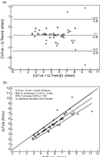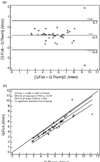Comparison of bedside measurement of cardiac output with the thermodilution method and the Fick method in mechanically ventilated patients
- PMID: 12720564
- PMCID: PMC270608
- DOI: 10.1186/cc1848
Comparison of bedside measurement of cardiac output with the thermodilution method and the Fick method in mechanically ventilated patients
Abstract
Introduction: Bedside cardiac output determination is a common preoccupation in the critically ill. All available methods have drawbacks. We wished to re-examine the agreement between cardiac output determined using the thermodilution method (QTTHERM) and cardiac output determined using the metabolic (Fick) method (QTFICK) in patients with extremely severe states, all the more so in the context of changing practices in the management of patients. Indeed, the interchangeability of the methods is a clinically relevant question; for instance, in view of the debate about the risk-benefit balance of right heart catheterization.
Patients and methods: Eighteen mechanically ventilated passive patients with a right heart catheter in place were studied (six women, 12 men; age, 39-84 years; simplified acute physiology scoreII, 39-111). QTTHERM was obtained using a standard procedure. QTFICK was measured from oxygen consumption, carbon dioxide production, and arterial and mixed venous oxygen contents. Forty-nine steady-state pairs of measurements were performed. The data were normalized for repeated measurements, and were tested for correlation and agreement.
Results: The QTFICK value was 5.2 +/- 2.0 l/min whereas that of QTTHERM was 5.8 +/- 1.9 l/min (R = 0.840, P < 0.0001; mean difference, -0.7 l/min; lower limit of agreement, -2.8 l/min; upper limit of agreement, 1.5 l/min). The agreement was excellent between the two techniques at QTTHERM values <5 l/min but became too loose for clinical interchangeability above this value. Tricuspid regurgitation did not influence the results.
Discussion and conclusions: No gold standard is established to measure cardiac output in critically ill patients. The thermodilution method has known limitations that can lead to inaccuracies. The metabolic method also has potential pitfalls in this context, particularly if there is increased oxygen consumption within the lungs. The concordance between the two methods for low cardiac output values suggests that they can both be relied upon for clinical decision making in this context. Conversely, a high cardiac output value is more difficult to rely on in absolute terms.
Figures



Comment in
-
Why measure cardiac output?Crit Care. 2003 Apr;7(2):114-6. doi: 10.1186/cc1863. Epub 2003 Jan 10. Crit Care. 2003. PMID: 12720554 Free PMC article.
Similar articles
-
Lack of agreement between thermodilution and fick cardiac output in critically ill patients.Chest. 2002 Sep;122(3):990-7. doi: 10.1378/chest.122.3.990. Chest. 2002. PMID: 12226045
-
[Comparison of 2 modified Fick methods and thermodilution for determining the cardiac output in patients with mechanical ventilation].Minerva Anestesiol. 1995 May;61(5):191-9. Minerva Anestesiol. 1995. PMID: 7478050 Clinical Trial. Italian.
-
Oxygen Fick and modified carbon dioxide Fick cardiac outputs.Crit Care Med. 1994 Jan;22(1):86-95. doi: 10.1097/00003246-199401000-00018. Crit Care Med. 1994. PMID: 8124981
-
Continuous measurement of cardiac output by the Fick principle in infants and children: comparison with the thermodilution method.Intensive Care Med. 1996 May;22(5):467-71. doi: 10.1007/BF01712169. Intensive Care Med. 1996. PMID: 8796404 Review.
-
Methods in pharmacology: measurement of cardiac output.Br J Clin Pharmacol. 2011 Mar;71(3):316-30. doi: 10.1111/j.1365-2125.2010.03798.x. Br J Clin Pharmacol. 2011. PMID: 21284692 Free PMC article. Review.
Cited by
-
Time to Calm the Fick Down? A Systematic Review and Meta-Analysis of Thermodilution Compared to Direct Fick in Tricuspid Regurgitation.CJC Open. 2024 May 24;6(9):1138-1144. doi: 10.1016/j.cjco.2024.05.008. eCollection 2024 Sep. CJC Open. 2024. PMID: 39525819 Free PMC article. Review.
-
Perioperative Quality Initiative (POQI) consensus statement on perioperative assessment of right ventricular function.Perioper Med (Lond). 2023 Dec 8;12(1):66. doi: 10.1186/s13741-023-00351-x. Perioper Med (Lond). 2023. PMID: 38066632 Free PMC article. Review.
-
Electrical velocimetry as a tool for measuring cardiac output in small infants after heart surgery.Intensive Care Med. 2012 Jun;38(6):1032-9. doi: 10.1007/s00134-012-2530-3. Epub 2012 Mar 30. Intensive Care Med. 2012. PMID: 22460851
-
How to Reliably Measure Stroke Volume Index in Pulmonary Arterial Hypertension: A Comparison of Thermodilution, Direct and Indirect Fick, and Cardiac MRI.Life (Basel). 2025 Jan 3;15(1):54. doi: 10.3390/life15010054. Life (Basel). 2025. PMID: 39859994 Free PMC article.
-
Validation of a new method based on ultrasound velocity dilution to measure cardiac output in paediatric patients.Intensive Care Med. 2013 May;39(5):926-33. doi: 10.1007/s00134-013-2848-5. Epub 2013 Feb 22. Intensive Care Med. 2013. PMID: 23430016
References
-
- Ganz W, Donoso R, Marcus HS, Forrester JS, Swan HJ. A new technique for measurement of cardiac output by thermodilution in man. Am J Cardiol. 1971;27:392–396. - PubMed
-
- Goldenheim PD, Kazemi H. Current concepts. Cardiopulmonary monitoring of critically ill patients (1). N Engl J Med. 1984;311:717–720. - PubMed
-
- Goldenheim PD, Kazemi H. Cardiopulmonary monitoring of critically ill patients (2). N Engl J Med. 1984;311:776–780. - PubMed
-
- Levett JM, Replogle RL. Thermodilution cardiac output: a critical analysis and review of the literature. J Surg Res. 1979;27:392–404. - PubMed
-
- Nishikawa T. Hemodynamic changes associated with thermodilution cardiac output determination in canine acute blood loss or endotoxemia. Acta Anaesthesiol Scand. 1993;37:602–606. - PubMed
Publication types
MeSH terms
LinkOut - more resources
Full Text Sources

